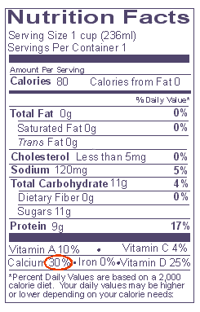Calcium and Vitamin D in Your Diet
Why are Calcium and Vitamin D needed?
- Calcium helps build and maintain strong bones and teeth.
- Vitamin D helps the body absorb calcium. Sunlight helps the body make vitamin D. During the winter, it can be hard to get enough daily sunlight.
- Some medicines, such as oral steroids increase the risk for bone loss. To protect the bones, a calcium-rich diet is needed.
What are the best ways to get Calcium and Vitamin D?
- Choose 3 to 4 servings from the milk and dairy group every day.
- Add extra milk or cheese to pizza, soups, macaroni and cheese and baked goods.
- Limit carbonated or caffeinated drinks like coffee, tea and soda. These drinks make it hard for the body to use the calcium.
- Weight bearing workouts at least three to four times a week will also help your bones stay strong. Walking, jogging, dancing, jumping rope, aerobics and skating are all good weight bearing exercises.
- Avoid smoking and alcohol. They prevent calcium from being absorbed into the bones.
How much Calcium or Vitamin D is needed?
Daily calcium needs by age
Age: 0 to 6 months
Calcium needed per day*: 200 mg
Vitamin D needed per day*: 400 IU
Age: 6 months to 1 year
Calcium needed per day*: 200 mg
Vitamin D needed per day*: 400 IU
Age: 1 to 3 years
Calcium needed per day*: 700 mg
Vitamin D needed per day*: 600 IU
Age: 4 to 8 years
Calcium needed per day*: 1,000 mg
Vitamin D needed per day*: 600 IU
Age: 9 to 18 years
Calcium needed per day*: 1,300 mg
Vitamin D needed per day*: 600 IU
Age: 19 to 30 years
Calcium needed per day*: 1,000 mg
Vitamin D needed per day*: 600 IU
*Based on the 2010 Review of DRI’s (Dietary Reference Intakes)
How much calcium and vitamin D is in foods?
Use the chart to know the amounts of calcium and vitamin D in different foods. Take note of portion sizes. In general, dairy foods have the most natural calcium and are usually fortified with vitamin D. *Not all brands are fortified with vitamin D and/or calcium. Be sure to read food labels to pick brands with vitamin D added.
Calcium food sources
Product: Milk
Amount: 8 ounces (1 cup)
Calcium*: 300 mg
Product: Cheese*
Amount: 1 ounce
Calcium*: 215 mg
Product: Fortified soy milk, plain and flavored
Amount: 8 ounces (1 cup)
Calcium*: 300 mg
Product: Yogurt*
Amount: 5.3 ounces (1 container)
Calcium*: 180 mg
Product: Frozen yogurt
Amount: 1/2 cup
Calcium*: 100 mg
Product: Cottage cheese
Amount: 1/2 cup
Calcium*: 95 mg
Product: Ice cream
Amount: 1/2 cup
Calcium*: 90 mg
Product: Pudding, ready to eat
Amount: 1 container
Calcium*: 50 mg
Product: Rhubarb, cooked
Amount: 1/2 cup
Calcium*: 175 mg
Product: Greens, cooked (collard greens, turnip greens, spinach)
Amount: 1/2 cup
Calcium*: 120 mg
Product: Canned beans (pinto, black, red, kidney), cooked
Amount: 1/2 cup
Calcium*: 80 mg
Product: Orange, medium
Amount: 1
Calcium*: 80 mg
Product: Peas, cooked
Amount: 1/2 cup
Calcium*: 45 mg
Product: Almonds
Amount: 1/4 cup
Calcium*: 100 mg
Product: Calcium fortified juice*
Amount: 8 ounces (1 cup)
Calcium*: 300 mg
Product: Calcium fortified cereal *
Amount: 1 cup
Calcium*: 110 to 1000 mg
Product: Calcium-fortified cereal bars *
Amount: 1 bar
Calcium*: 300 mg
Product: Cheese Pizza
Amount: 1 slice
Calcium*: 215 mg
Product: Macaroni and Cheese
Amount: 1/2 cup
Calcium*: 180 mg
Product: Molasses, blackstrap
Amount: 1 tablespoon
Calcium*: 170 mg
Product: Corn tortillas (6 inch)
Amount: 1 tortilla
Calcium*: 45 mg
Vitamin D food sources
Product: Cod Liver Oil
Amount: 1 tablespoon
Vitamin D: 1360 IU
Product: Salmon
Amount: 3 ounces
Vitamin D: 425 IU
Product: Tuna (canned in water)
Amount: 3 ounces
Vitamin D: 155 IU
Product: Calcium and Vitamin D-fortified juice*
Amount: 8 ounces (1 cup)
Vitamin D: 140 IU
Product: Pudding
Amount: 1 cup
Vitamin D: 100 IU
Product: Fortified soy milk, plain and flavored
Amount: 8 ounces (1 cup)
Vitamin D: 100 IU
Product: Milk
Amount: 8 ounces (1 cup)
Vitamin D: 100 IU
Product: Yogurt*
Amount: 5.3 ounces (1 container)
Vitamin D: 55 IU
Product: Eggs (yolk)
Amount: 1 egg
Vitamin D: 40 IU
Product: Calcium and Vitamin D-fortified cereal *
Amount: 1 cup
Vitamin D: 40 IU
* Using food labels to determine how much calcium and vitamin D is in a serving of a food
Both calcium and vitamin D are listed on the nutrition facts label as a percent daily value per serving. Use the rules below to figure out the amount of calcium or vitamin D in your food. Be sure to check the amount of food you are eating with the serving size listed.
Rule of thumb for percent daily value:
5% or less means the food is poor source of calcium or vitamin D
20% or more means the food is a good source of calcium or vitamin D

Calcium
- Add a zero to the percent daily value to know the amount of calcium per serving of the food.
- In the label, 30% means there is 300 mg calcium in this food
Note: This rule does not apply to all nutrients on a food label.
Vitamin D
- Multiply the percent daily value by 4 to know the amount of vitamin D per serving of the food.
- In the label, 25% x 4 = 100 IU vitamin D in this food
Note: This rule does not apply to all nutrients on a food label.
If your child does not consistently get enough calcium and vitamin D, then a supplement may be needed. Ask your doctor, dietitian or pharmacist for recommendations.



